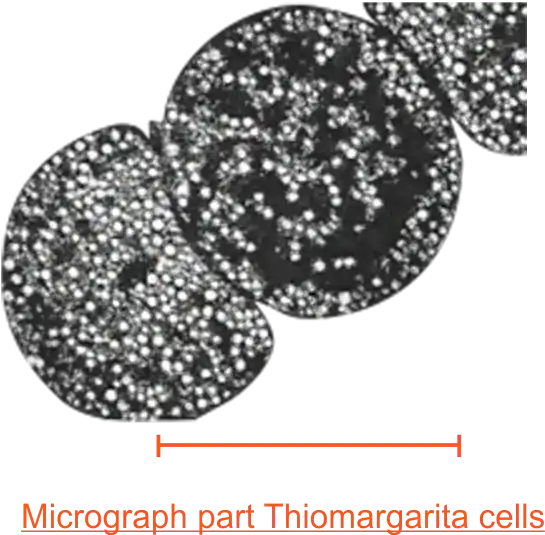Lesson Note and Lesson Plan on Biology
Magnification and resolution of a microscope
Subject: Biology
Theme: Microscope
Topic: Magnification and Resolution
Sub Topic: Magnification and Resolution of the Microscope.
Date: dd/mm/yyyy
Class: S.S.S 1
Duration: 30 Minutes
No of Learners: 30
Learning Objectives:
By the end of the lesson learners should be able to:Defined magnification and resolution.
Magnification refers to an increase in the apparent size of the object, while the resolution of a microscope is the ability to show two close objects as separate. The maximum magnification of an ordinary light microscope is about x1500. The magnification must be written on the right side and below the biological drawing and it does not have units. The size of the image is measured in mm but converted into micrometres or nanometres to work out the actual size.
Express the magnification Equation.

Example
Calculate the magnification if the actual size is 5μm and the measured image of the specimen has the size of 40mm.
Answer :
Make the size of the image and the actual size in the same units by converting mm in μm. This is done by multiplying 40mm by 1000 so that 40mm = 40000 μm

Note that the magnification of the specimen under a light microscope is calculated by multiplying the magnification of the objective used to that of the eyepiece. For example: 10x (objective) 10x (eyepiece) = x100.Use a magnification Scale bar to calculate magnification.
Magnification can be calculated using a scale bar. This is a line drawn near the photograph or drawing which has a label showing the actual length of the bar before being magnified.
Working out magnification:- Measure the scale bar image (besides drawing) in mm.
- Convert to µm (multiply by 1000).
- Magnification = scale bar image divided by actual scale bar length (written on the scale bar) Example: The diagram below shows the characteristic rod-shaped structure of E. coli bacteria.


outline the procedure taken to prepare slides of microorganisms such as a bacterium, amoeba, and paramecium under a light microscope.
Apparatus/Materials:
Petri-dishes, plate covers, pencil, transparent tape, microscope, agar powder, and permanent slide of bacteria, amoeba, and paramecium, Bunsen burner or any other source of heat.
Procedure:- Prepare agar medium by boiling a mixture of 10g of agar powder with 50ml of water.
- Label control and exposed Petri dishes in which you pour prepared agar medium.
- Cool both plates for 20 minutes until the medium hardens.
- Tape closed the cover of the control plate and removes the cover of the exposed plate.
- Leave both plates for 5 minutes, and do not touch or breathe on the agar. After five minutes, tape closed the lid of the exposed plate and store both plates upside down in a warm place and draw your observations.
- Repeat the observation by using mounted slides of amoeba and paramecium and make a comparison between bacteria, amoeba and paramecium: what is your conclusion?
NOTE:
For this experiment, a light microscope allows to observe organisms of small size including bacteria, amoeba and paramecium. Some other parts of macroscopic organisms such as cells and tissues of plants and animals or some parts of these living organisms such as stems and roots can also be observed under the light microscope. Some specimens can be observed directly after collection and preparation. However, some of the details might not be observed because specimens are not coloured. Also, some material distorts when you try to cut the specimen into thin sections. To overcome this challenge, slides can be prepared in advance by the use of the following steps:
- Staining: coloured stains are chemicals that bind to chemicals on or in the specimens. This allows the specimen to be seen. Some stains bind to specific cell structures. For example, acetic orcein stains DNA dark red, while gentian violet stains bacterial cell walls.
- Sectioning: specimens are embedded in wax, where thin sections are then cut without distorting the structure of the specimen. This is particularly useful for making sections of soft tissue, such as the brain. Safety measures might be taken. Make sure that hands are washed with soap and warm water after the experiment. Use a disinfectant to wipe down all surfaces where bacteria may have been deposited for example. Be sure that some substances and animals might be harmful to life.
Prepare temporary slides of onions young stems by fixing, staining and mounting under low and high power of a light microscope
Preparation and procedures:
- Add a drop of water at the centre of the microscopic slide to flatten the membrane.
- Pull a thin membrane from the onion layer and lay it at the centre of the microscopic slide.
- Add a drop of an iodine solution or methylene blue on the onion membrane.
- Gently lay a microscopic coverslip on the membrane and press it down gently using a needle to remove air bubbles.
- Touch a blotting paper on one side of the slide to drain excess iodine/water solution.
- Place the slide on the microscope stage under low power to observe.
- Adjust focus for clarity to observe.
- Make another slide without adding the stain to see the difference between a stained slide and a non-stained slide.
- Draw and label the observed parts of each of the two slides and compare a drawing of a stained slide and that of a non-stained slide.
Measuring cells with the aid of the microscope.
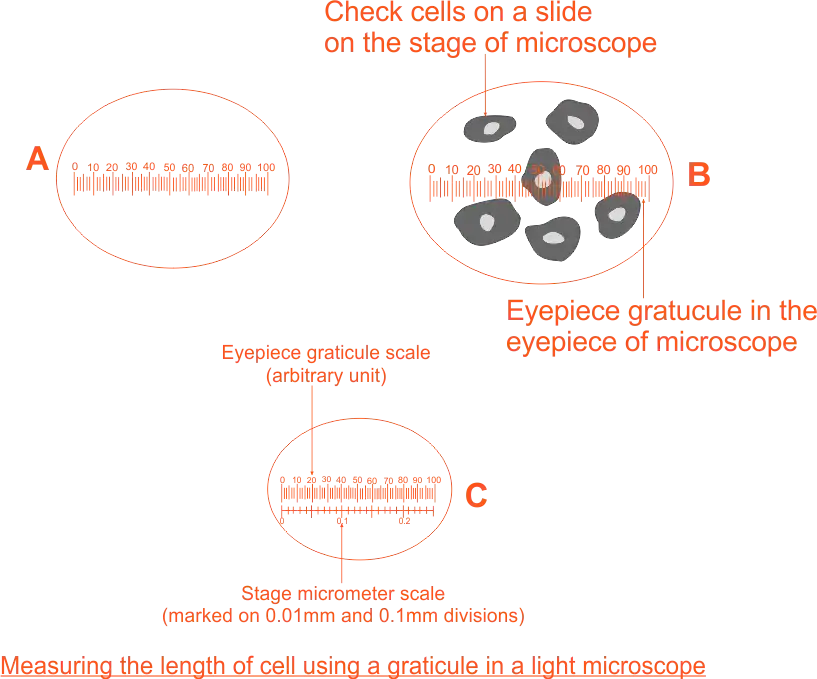
Cells and organelles can be measured with a microscope using an eyepiece called a graticule. This is a transparent scale, usually having 100 divisions (Figure A). The eyepiece graticule is placed in the microscope eyepiece so that it can be seen at the same time as the object to be measured (Figure B). At this figure (Figure B), the cell lies between 40 and 60 on the scale, so that it measures 20 eyepiece units in diameter (60 – 40 = 20).
To calibrate the eyepiece graticule scale, a miniature transparent ruler called a stage micrometre scale is placed on the microscope stage and is brought into focus. This scale may be fixed onto a glass slide or printed on a transparent film. It commonly has subdivisions of 0.1 and 0.01 mm. The images of the two scales can then be superimposed (Figure C). If in the eyepiece graticule, 100 units measure 0.25mm, the value of each eyepiece unit equals 0.25 ÷ 100 = 0.0025mm
By converting mm to μm, the value of eyepiece equals (0.25 x 1000) ÷ 100 = 2.5μm
The diameter of the cell shown superimposed (Figure B) measures 20 eyepiece units. Its actual diameter equals 20 × 2.5 μm = 50 μm. This diameter is greater than that of many human cells because the cell is a flattened epithelial cell.Use the following instructions to measure the length of one cell
- Measure the distance in millimetre from the start of one cell to the end of 10 cells
- Divide by 10 to find the length of one cell in the specimen.
- Convert this length in millimetres to a micrometre by multiplying by 1000.
- Find the actual length of a cell by dividing this length by the magnification of the specimen got from the product of the eyepiece and objective lens used.
Rationale:
The microscope is important because biology mainly deals with the study of cells (and their contents), genes, and all organisms. Some organisms are so small that they can only be seen by using magnifications of X2000 - X25000, which can only be achieved by a microscope. Cells are too small to be seen with the naked eye. Genetics is the study of variations in an organism generation after generation. Genetic engineering requires the mixing of genes. Genes are even smaller than cells, which is why microscopes are essential to genetics. Without the microscope, biology would not have been so developed and many diseases would still have no cure.
Prerequisite/ Previous knowledge:
The learners can work out basic equivalent measurements.Learning Materials:
Microscopes, micrographs, writing materials, and diagrams.Reference Materials:
- Kent M. (2000). Advanced Biology. Oxford University Press, Oxford, UK.
- Campbell, N.A, et al. (2008). Biology, Pearson International Edition, San Francisco, USA, 8th edition.
- Pete K. Frank S. (2008). OCR Biology. Pearson Education Limited. British.
- Miller, Levine (2008). Prentice-Hall Biology. Pearson Education. The USA.
- Online resources.
Lesson Development:
STAGE |
TEACHER'S ACTIVITY |
LEARNER'S ACTIVITY |
LEARNING POINTS |
|---|---|---|---|
| INTRODUCTION full class session (10 mins) |
Asking some questions: Work out the following equivalent measurements:
Teachers should ensured learners note the S.I. Units of MAGNIFICATIONS & SCALES
|
Learners' expected response.
|
Learner’s entry points. Competences: Critical thinking, Communication. |
| STEP 1 10 mins. Development |
Ask students to form three groups. | Form three groups and share responsibility. | Inculcating leadership skills, competitive spirit, cooperation, teamwork, and a sense of responsibility among learners. |
| The teacher provides learners with materials (microscopes, microcell, and prepared micrographs or diagrams containing the structures of different animal cells and plant cells, etc) and instructions and allows them to identify the materials, state their observation hence defining the term magnification and resolution in their own words. The teacher guides learners to write the mathematical formula of magnification.  The teacher gives learners an exercise to try.
|
Students identify the materials as; microscopes, microcells, and prepared micrographs or diagrams containing the structures of different animal cells and plant cells, and observed that the size of the object increased when viewed with the microscope. Hence define magnification and resolution. Magnification refers to an increase in the apparent size of the object, while the resolution of a microscope is the ability to show two close objects as separate. 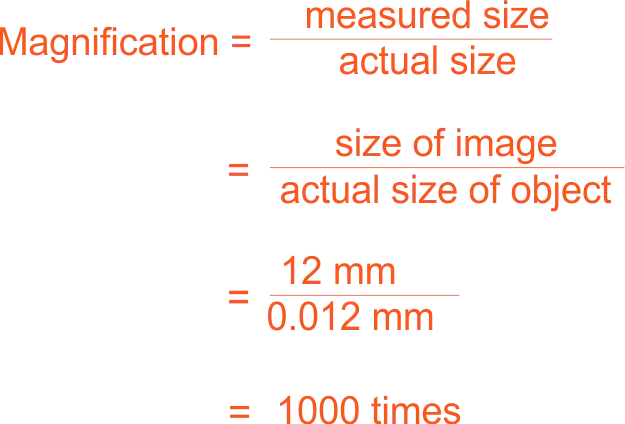  |
Being able to identify the materials/apparatus and define magnification and resolution of the Compound Light Microscope and able to calculate the magnification of a compound light microscope. Competencies: Problem-solving, communication, manipulation, cooperation, and Critical thinking. |
|
The teacher-guided students to calculate the magnification of the scale bar.
|
 |
Calculate the magnification of these scale bars | |
| Stage 2 Microscopic observation 10 mins |
The teacher provide learners in groups different prepared slides of microorganisms of bacterium, amoeba, and paramecium, Petri-dishes, plate covers, pencil, transparent tape, microscope, agar powder, and permanent slide of bacteria, amoeba, and paramecium, Bunsen burner or any other source of heat, and ask learners to observe, draw and label the visible parts of the bacterium, amoeba, and paramecium under a light microscope. Teachers should provide learners with the procedure and monitor how the students are progressing towards the knowledge, skills, and attitudes to be learned and boost those who are still behind (but without communicating to them the knowledge). The teacher asks learners to state their conclusion? |
The students follow the teacher's directives. Students work collaboratively on the task. Both boys and girls participate actively to observe, draw and label the visible parts of bacterium, amoeba, and paramecium in the group under a light microscope. PROCEDURE
|
Microscopic observation using prepared slides of microorganisms such as a bacterium, amoeba, and paramecium. |
| The teacher-guided learners in groups on how to Preparing of temporary slides of the epidermis of onions young stems by fixing, staining and mounting and observation under the light microscope. | Learners follow teachers directives in preparation and procedures:
|
Communication; Using the light microscope in preparing temporary slides and observing under the light microscope. | |
| STEP 3 Measuring cells 5 mins |
The teacher guides learners on how to measure cells and organelles can be measured with a microscope using an eyepiece called graticule. |  Students follow the teacher's instructions.
|
Collaboration among group members, manipulation of results, and measuring the length of the cell using a graticule in a light microscope. |
| EVALUATION 10 mins |
The teacher asks the students questions.
|
Learners respond to the teacher's questions. | Asking the learners questions to assess the achievement of the set objectives. |
| CONCLUSION 2 mins |
Teachers wrap up from the learners' observations, summarise the learned knowledge, and give more clarification on the learned content. The microscope uses transmitted light for observation. However, a microscope uses specific light characteristics for specific samples, such as transparent specimens and samples that do not pass light. All parts of a microscope work together, the light from the illuminator passes through the aperture, through the slide, and through the objective lens, where the image of the specimen is magnified. Then the magnified image continues up through the body tube of the microscope to the eyepiece, which further magnifies the image the viewer can see. Light from the source is focused on the specimen by the condenser lens. It then enters the objective lens, where it is magnified to produce a real image. The real image is magnified again by the ocular lens to produce a virtual image that is seen by the eye. |
Participate actively in summarizing the content. Making short notes. |
Listening skills, Writing skills. |
| Assessment/ Assignment: 5 mins |
The teachers give learners a take home and engage students to work individually.
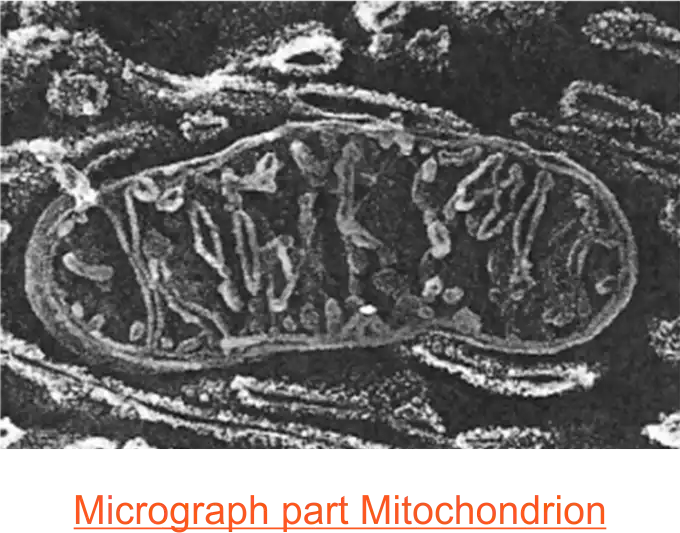 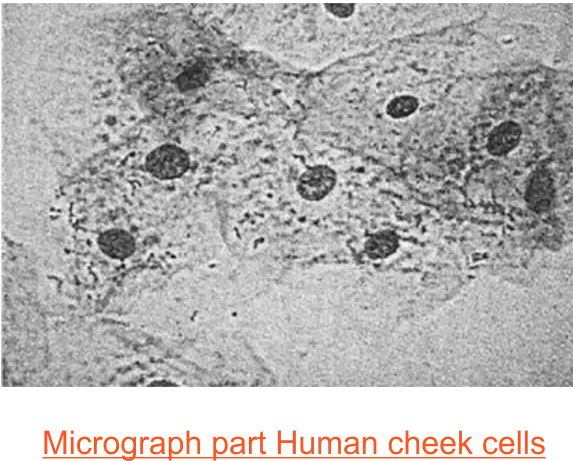 |
Do exercises.
|
Competences: Creativity. |
